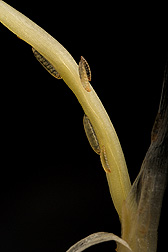This page has been archived and is being provided for reference purposes only. The page is no longer being updated, and therefore, links on the page may be invalid.
Read the magazine story to find out more. |
|
|
Virulent Hessian Flies Renew Attack on U.S. Wheat
By Don ComisJanuary 24, 2007
Last year, the West Lafayette, Ind., area saw its first Hessian fly (Mayetiola destructor) infestation in more than a decade. Over the last two years, the flies have also shown up in Missouri for the first time ever, signaling a westward expansion of the world's most destructive wheat pest.
Having mostly lurked outside of wheat fields for the past 45 years, the flies have recently undergone genetic changes that enable them to make major inroads into wheat fields once again.
It so happens that both the Agricultural Research Service's (ARS) Crop Production and Pest Control Research Unit and Purdue University—part of a research team that pioneered control of the Hessian fly—are located in West Lafayette.
With this team's continuous help in breeding and updating genetic resistance to the fly, wheat has been winning the battle against the pest since 1955, by which time the first three Hessian fly-resistant wheat genes had been bred into wheat varieties.
But by 2000, the flies had overcome four of the latest primary wheat resistance genes that had protected wheat successfully since 1986. This is the fly's latest success in a 10,000-year-old, gene-for-gene battle with wheat. ARS molecular biologist Christie Williams and colleagues at West Lafayette discovered and mapped the newest wheat genes, H31 and H32.
|
Aided by the latest genetic tools, the West Lafayette scientists are hunting for fly genes as well. They now have enough gene markers to cover the entire Hessian fly genome. With these, they have begun a search for all of the fly genes that overcome resistance genes in wheat.
ARS entomologist Brandon J. Schemerhorn is sampling Hessian flies across the United States to determine their genetic variability. The greater the variability, the more resistance genes will need to be bred into wheat varieties to counter the fly's genes.
Read more about the research in the January 2007 issue of Agricultural Research magazine.
ARS is the U.S. Department of Agriculture's chief scientific research agency.


